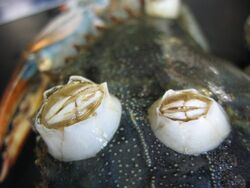Biology:Chelonibia
| Chelonibia | |
|---|---|

| |
| Chelonibia patula on the blue crab Callinectes sapidus | |
| Scientific classification | |
| Domain: | Eukaryota |
| Kingdom: | Animalia |
| Phylum: | Arthropoda |
| Class: | Thecostraca |
| Subclass: | Cirripedia |
| Order: | Balanomorpha |
| Superfamily: | Coronuloidea |
| Family: | Chelonibiidae Pilsbry, 1916 |
| Subfamily: | Chelonibiinae |
| Genus: | Chelonibia Leach, 1817 |
Chelonibia is a genus of acorn barnacles in the family Chelonibiidae of the subphylum Crustacea.[1] Its members are epizootic and live attached to manatees, turtles, marine molluscs, crabs and horseshoe crabs in all tropical and subtropical oceans.[2] In a few instances, they have been found on sea snakes,[3] alligators[4] and inanimate substrates,[5] but they are not found in the typical habitats of barnacles – on rocks, docks or boats.
Phylogeny
They appear to be the sister group to the Balanidae.[6]
Fossils
The fossil record of Chelonibia ranges back to the Miocene.[7]
Species
The genus contains four extant species:[8][9]
- Chelonibia caretta (Spengler, 1790)
- Chelonibia manati Gruvel, 1903
- Chelonibia patula (Ranzani, 1818)
- Chelonibia testudinaria (Linnaeus, 1758)
Recent molecular genetic work suggests that three of the species, Chelonibia manati, C. patula and C. testudinaria, are all the same species. Depending on the host species, they develop plastically very distinct morphology but cannot be distinguished on the genetic level.[10]
Three species are only known from the fossil record:
- Chelonibia capellini de Alessandri, 1895
- Chelonibia depressa Seguenza, 1876
- Chelonibia hemisphaerica Rothpletz & Simonelli, 1890
References
- ↑ Chan, Benny K. K.; Dreyer, Niklas; Gale, Andy S.; Glenner, Henrik et al. (2021). "The evolutionary diversity of barnacles, with an updated classification of fossil and living forms". Zoological Journal of the Linnean Society. doi:10.1093/zoolinnean/zlaa160.
- ↑ Newman, William A.; A. Ross (March 31, 1976). "Revision of the balanomorph barnacles including a catalog of the species". San Diego Society of Natural History Memoirs 9: 1–109.
- ↑ Badrudeen, M. (2000). "On the occurrence of the cirriped barnacle, Chelonibia patula (Ranzani) on the sea snake, Hydrophis cyanocintus (Daudin)". Marine Fisheries Information Service, Technical and Extension Series 164: 25.
- ↑ Nifong, James; M. G. Frick (2012). "First record of the American alligator (Alligator mississippiensis) as a host to the sea turtle barnacle (Chelonibia testudinaria)". The Southeastern Naturalist 10 (3): 557–560. doi:10.1656/058.010.0316.
- ↑ Frazier, J. G.; D. Margaritoulis (1990). "The occurrence of the barnacle, Chelonibia patula (Ranzani, 1818), on an inanimate substratum (Cirripedia, Thoracica)". Crustaceana 59 (2): 213–218. doi:10.1163/156854090x00688.
- ↑ Perez-Losada, M.; M. Harp; J. T. Høeg; Y. Achituv; D. Jones; H. Watanabe; K. A. Crandall (2008). "The tempo and mode of barnacle evolution". Molecular Phylogenetics and Evolution 46 (1): 328–346. doi:10.1016/j.ympev.2007.10.004. PMID 18032070. http://crandalllab.byu.edu/Portals/20/docs/publications/Losada-Crandall_MPE08.pdf.
- ↑ Harzhauser, M.; W. A. Newman; P. Grunert (2011). "A new Early Miocene barnacle lineage and the roots of sea-turtle fouling Chelonibiidae (Cirripedia, Balanomorpha)". Journal of Systematic Palaeontology 9 (4): 473–480. doi:10.1080/14772019.2010.528053.
- ↑ Ryota Hayashi (2012). "A checklist of turtle and whale barnacles (Cirripedia: Thoracica: Coronuloidea)". Journal of the Marine Biological Association of the United Kingdom 93: 143–182. doi:10.1017/S0025315412000847.
- ↑ Benny K. K. Chan (2012). "Chelonibia Leach, 1817". WoRMS. World Register of Marine Species. http://www.marinespecies.org/aphia.php?p=taxdetails&id=106128.
- ↑ Cheang C; Tsang L; Chu K; Cheng I-J; Chan B (2013). "Host-Specific Phenotypic Plasticity of the Turtle Barnacle Chelonibia testudinaria: A Widespread Generalist Rather than a Specialist". PLoS ONE 8 (3): e57592. doi:10.1371/journal.pone.0057592. PMID 23469208. Bibcode: 2013PLoSO...857592C.
Wikidata ☰ Q3808976 entry
 |

